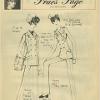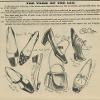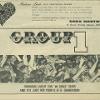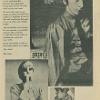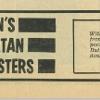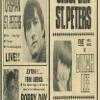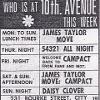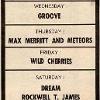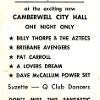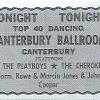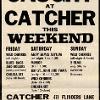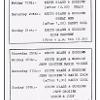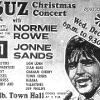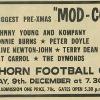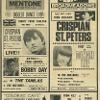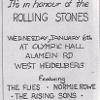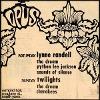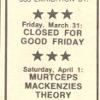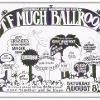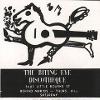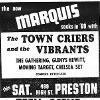'Mod' is a subculture that began in 1960s Britain and spread, in varying degrees, to other countries. Focused on music and fashion, the subculture has its roots in a small group of London-based stylish young men in the late 1950s who were termed 'Modernists' because they listened to modern jazz, although the subculture expanded to include women.
The immediate predecessors of the Mods were the ‘Teddy Boys’ or the ‘Teds’, a term coined when a 1953 Daily Express newspaper headline shortened Edwardian to 'Teddy'.
Mod History:
In 1958, a small group of tailor’s sons in East London adopted a smooth and sophisticated look, a combination of Italian and French styles of the period. They had Italian suits with narrow lapels impeccably tailor-made for themselves and wore them with pointed-collar shirts. The shoes of necessity were hand-made winklepickers, so named because of their extremely pointed toes which so closely resembled the pins used to pick the meat out of a type of snail called a periwinkle. To top off the look, mods wore their hair short and neat, following the lead of French film stars. Great pains were taken to get the hairstyle just right.
Mods inherited the narcissistic and fastidious tendencies of the Teds regarding their appearance. Dressing for show was transformed into a religion as British youth demolished the notion of male clothing as merely a status indicator. Until this time, it had been a common stereotype that only homosexuals were interested in fashion. The mods trampled on this idea as well; clothing took precedence over all else.
Male mods adopted a smooth, sophisticated look that included tailor-made suits with narrow lapels (sometimes made of mohair), thin ties, button-down collar shirts, wool or cashmere jumpers (crewneck or V-neck), Chelsea or Beatle boots, loafers, Clark's desert boots, bowling shoes, and hairstyles that imitated the look of French Nouvelle Vague film actors. A few male mods went against gender norms by using eye shadow, eye-pencil or even lipstick.
Many female mods dressed androgynously, with short haircuts, men's trousers or shirts, flat shoes, and little makeup — often just pale foundation, brown eye shadow, white or pale lipstick and false eyelashes. Miniskirts became progressively shorter between the early and mid-1960s. As female mod fashion became more mainstream, slender models like Jean Shrimpton and Twiggy began to exemplify the mod look. Maverick fashion designers emerged, such as Mary Quant, who was known for her miniskirt designs, and John Stephen, who sold a line named 'His Clothes' and whose clients included bands such as Small Faces. The television program Ready Steady Go! helped spread awareness of mod fashions to a larger audience.
The interests of early mods, who at this point were fairly small in number, were things that would maintain their ‘cool’ image, such as modern jazz music and Jaguar cars; however, relatively small salaries afforded them only motor scooters for transportation. The most popular models, Italian Vespas and Lambrettas, has a sleek, ‘cool’ shape and the advantage of being less oily than motor bikes; therefore, sparing much damage to silk suits. For extra protection and cleanliness, the mods (or modernists), took to wearing parkas, all-weather cape coats with fur-lined hoods in regulation army green, though some mods would dye them colours to match their scooters.
The original mods gathered at all-night clubs such as The Flamingo and The Marquee in London to hear the latest records and show off their dance moves. Another favourite was Le Kilt, which was often filled with young French women whose ‘cool’ image they greatly admired. As the mod subculture spread across the United Kingdom, other clubs became popular, including Twisted Wheel Club in Manchester.
The early mods also listened to the "sophisticated smoother modern jazz" of musicians such as Miles Davis, Charlie Parker, Dave Brubeck and the Modern Jazz Quartet, as well as the American rhythm and blues (R&B) of artists such as Bo Diddley and Muddy Waters. Starting around 1960, mods embraced the off-beat, Jamaican ska music of artists such as the Skatalites, Owen Gray, Derrick Morgan and Prince Buster on record labels such as Melodisc, Starlite and Bluebeat.
The British R&B/rock bands The Rolling Stones, The Yardbirds and The Kinks all had mod followings, and other bands emerged that were specifically mod-oriented. These included The Who, Small Faces, The Creation, The Action, The Smoke and John's Children. The Who's early promotional material tagged them as playing "maximum rhythm and blues", and a name change in 1964 from The Who to The High Numbers was an attempt to cater even more to the mod market. After the commercial failure of the single 'I'm the Face / Zoot Suit', the band changed its name back to The Who. Although The Beatles dressed like mods for a while (after dressing like rockers earlier), their beat music was not as popular as British R&B among mods.
There was a very
general breakdown of cliques within the mod culture, into three loosely defined
groups: the 'Mainstream Mods', the 'Scooter Boys', and the 'Hard Mods'. Mainstream mods entertained most styles of the subculture from time to time, but generally
dressed in Italian silk suits with narrow lapels. Colours ranged from grey and
black to brown, red and green. Drainpipe trousers were cut above the ankle to
reveal Italian tasseled loafers for basket-weave casuals, usually with pointed
toes. Ties were always very thin and usually black, worn around the necks of
button-down shirts. Turtlenecks were also popular in wool or cashmere, as were crewneck and V-neck sweaters and polo knit shirts buttoned to the throat, with
horizontal stripes being the preferred pattern. Hair was razor-short and often
topped with a black bowler. Mods sported dark glasses, in keeping with the
‘cool’ image. Scooter Boys opted for a more casual attire, wearing anoraks and army parkas for warmth.
Shrink-to-fit Levis were popular with the mods, often in black. Like the mainstream mods, Scooter Boys donned sweaters of wool or cashmere, but paired them up with plaid or checked trousers. They also outfitted their scooters, dressing them up with mirrors, headlights and fog lamps around the handlebars. Hard Mods, a group that gradually evolved into Skinheads, were aggressively working-class males who wore mainly jeans and work boots. Doctor Martens were and are a popular work boot due to their exceptional strength and fit.
A notable part of the mod subculture was recreational amphetamine use, which was used to fuel all-night dances at clubs. Newspaper reports described dancers emerging from clubs at 5 a.m. with dilated pupils. Some mods consumed a combined amphetamine / barbiturate called Drinamyl, nicknamed "purple hearts."
The Decline of 1960s Mod in the UK:
During the early to mid-1960s, as mod grew and spread throughout the UK, certain elements of the mod scene became engaged in well-publicised clashes with members of a rival subculture: rockers. Media coverage of the two groups fighting in 1964 sparked a "moral panic" about British youth, and they became widely perceived as violent, unruly troublemakers.
By 1965, conflicts between mods and rockers began to subside and mods increasingly gravitated towards pop art and psychedelia. By this time, the subculture had become a mass commercial phenomenon and the working-class rebels who had helped to create the original cult disapproved of it, could no longer identify with it, and were beginning to lose interest. Wealthy pop aristocrats opened their own clubs, feeding off of the popularity of the style, white the original mods were left in their 9-to-5 jobs, feeling cheated and upstaged. They were also growing older, starting families and careers and establishing homes for themselves. As all fads do, the image gradually lost the limelight and was eclipsed by the hippies and the steadily growing drug culture of the late sixties.
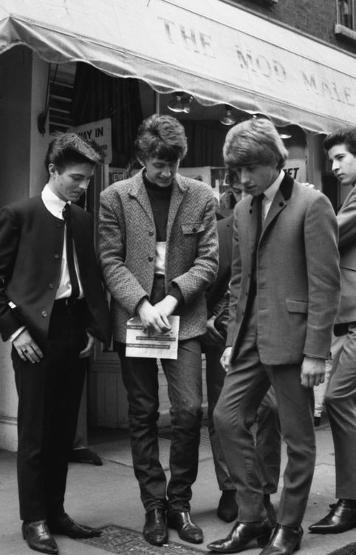
The mod male, London 1960's - Source: The Swinging Sixties

Mods, 1960s - Photo by Paul Anderson - Source: Pinterest


Mods try on 'Beatle' boots, 1965 - Photo by Terry Spencer

Twiggy wearing a Mary Quant design, 1966 - Source: Thatsnotmyage

The Small Faces looking at knitwear, 1966 - Photo by Tony Gale


Mod came to Melbourne in around 1964, with Australian fashion being a few years behind that of the UK due to distance and the length of time it would take for fashion magazines to arrive. But with the influx of the 'Ten Pound Pom' movement, that had reached its peak by 1969, many UK kids were arriving in Australia with their mod fashion in tow.
By 1963 in Australia, the “first wave” of rock ‘n roll had started to abate and decline in popularity, in line with decreasing interest in the “fad” from around the world. With the explosion of the new 'Beat' sound, a British popular music genre that developed, particularly in and around Liverpool in the late 1950s and early 1960s, it took little time for bands such as The Beatles, The Rolling Stones, The Who, The Hollies, Cilla Black, The Kinks, The Dave Clark Five, Gerry and the Pacemakers, Brian Poole and the Tremeloes, Procol Harem, The Small Faces, The Spencer Davis Group and a myriad of other British Beat bands to sweep into the Australian Top 40 Charts and entrench themselves here, as they had done throughout the rest of the world.
Very soon, a distinctive form of sixties Australian progressive rock was to develop and Melbourne, boasting the top venues in the country, became the place to show just what a band could deliver unfettered in a live context. Many of the country’s top singers and groups relocated here from other states as the scene began to take shape. This city also had a large, music-hungry and appreciative public to enjoy the experience.
Melbourne Mod Fashion:
In the 1960s, fashion was as diverse as one's social status, educational levels, work experience, marital status or interest in fashion. IN addition, the media (print, film and TV) also had an influence on fashion.
In 1964, fashion designer Prue Acton opened her first shop in the Block Arcade, Collins Treet, Melbourne. By 1966 the shop was doing a roaring trade with girls aged 14 - 24, and Prue appearing throughout the fashion press, from Go-Set magazine to Vogue Her shop sold everything a girl could want to create an up-to-the-minute look, including dresses, trousers, tops, handbags hats, stockings and cosmetics.
Her shop offered an Australian adaptation of 'Swinging London', in particular Mary Quant, 'Mod' and 'Op Art' looks.
The English mod look translated to the Australian fashion scene as mini dresses (hemlines well above the knee) in a shift style, sleeveless, usually in black and white, but sometimes in red, white and blue or navy and white with geometric lines and angular patterns.
Just as the mod look was adapted to an Australian audience, so too was the English Briget Riley inspired 'Op Art' form - kinetic patterns in black and white and almost fluorescent colours. Many of the dress designs that featured Op Art patterns were similarly cut to mod dresses - sleeveless with a round neck and above the knee hemline. Often, too these dresses had cut out deigns that sometimes exposed the skin or were backed with a plastic material that added to the geometric design of the patterning of the dress.
Op Art outfits could be worn with plain or patterned hosiery and boots and were often complemented with a handbag, angular, geometric sunglasses and fun plastic dangling earrings in colours to match the dress. A Bob haircut could be worn with a helmet styled hat to show off the pointed angles of their bob haircut around the jaw or their fringes.
Op Art fashion was not confined to women's wear. Boys could also buy Op Art shirts, where the shirt body would have an Op Art print with contrasting collar and cuffs. Boys tended to wear straight leg trousers with desert boots or Beatle boots featuring black pointy toes with a Cuban heel.
Along with Prue Acton, it wasn't long before other Melbourne fashion boutiques were importing the latest fashion from designers and manufacturers in England, Europe and Hong Kong.
'Meredith' 'House of Merivale', the 'In Shop' (Myer), 'Cherry Lane', 'Emma', 'Buckley and Nunn's', 'Georges' and Darrods Department Store all started catering specifically to the mod look. Other Designers who were important at that time were Norma Tullo and Kenneth Pirrie.
"Established by John and Merivale Hemmes, the landmark House of Merivale and clothing designed by Merivale revolutionised the Australian fashion scene. John and Merivale Hemmes were mavericks in Australian fashion. Modelled on London’s famous concept boutiques and catering to 18–25-year-olds, the House of Merivale was the first specialty fashion boutique in Australia.
The House of Merivale was not just a shop; it was a phenomenon that significantly influenced a generation of young Australian’s attitude to shopping and the fashion experience. The House of Merivale was the place to go to for the latest trends in music, fashion and make-up and was the first store in Australia to sell the mini. The popularity of the boutique was such that teenagers would be lined up outside the door." (Powerhouse Museum Collection)
But while many of these inner-city boutiques were now and selling their clothing and accessories to an affluent middle- class clientele, many of Melbourne's youth had to be content with creating their own home-made mod look with whatever fashion items and fabric that was available to them. This was mainly due to the fact that a person on a low income simply could not afford to constantly buy new clothes. If, for example, a dress cost $10 at the end of 1966, someone on a shopgirl wage might be able to purchase one once a month, but certainly not once a week. Also, as so many mothers and daughters could sew, fashionable fabrics and dressmaking patterns would be made available in stores for a longer period of time than finished garments in a fashion boutique.
Mary Renshaw recalls her attempt at creating the mod look in 1964 when she was a teenager:
"There was an older group of mods and there was us young kids in high school dressing in our flares in which we thought were mod. What we called mod shoes were a slightly round toed T-bar, with a tiny little kitten heel. Our mod attire was these shoes, a pair of flares, a skinny ribbed jumper and round glasses. We were making up our own special version of mod and there was one special magazine rock magazine that you could buy at the newsagents; I think it was called 'FAB' and it had all the music that was happening over in London and it also had a bit of fashion too and I can remember getting my mum to make me a dress which was a tartan dress with a big vee, a bar across it and little buttons, a big frilly white lace shirt underneath it. Very much Adam Ant many years later. There were three different hairstyles - The Mia Farrow look with really short hair, the Bob and there was the really long hair with the really thick fringe."
Dolores San Miguel, who would later become the mother of the Melbourne punk scene, also recalls her foray into the mod subculture in 1964, when she was 14 years old:
"I was probably around 14 when I was looking at English fashion like Mary Quant clothes. My mother was getting the patterns for me and making the crepe dresses. I clearly remember one pair of shoes what I was wearing after I’d met the guy from the band The Cherokees. I was only 15. He’d given me his address. I had this dress, which I think I got from Myer, and it was like felt and it was purple and lime green and I had purple stockings, because I don’t think pantyhose had been introduced at that stage, and the shoes were patent leather, and they were bright purple, and they had a square chunky heel. I was an apprentice hairdresser and I always had long hair; I never had a fringe back then that suited me.
Media:
The way that many of the 1960's youth found out about the latest music, fashion and events was through the alternative media of the day that included the triumvirate:
- The Go!! Show (also known simply as Go!!), an Australian popular music television series which was produced before a live audience and aired and on Network Ten ATV-0, Melbourne, from August 1964 to August 1967, running one hour three nights a week.
- Go!! Records (usually badged as Go!! Records), a small independent Melbourne-based recording label which ran from 1964 to 1968. Its releases were to promote the 'house' artists who appeared on the show, and new discoveries and were manufactured and distributed by the Melbourne-based recording and electronics company Astor.
- Pop magazine GO-SET (1966–1974) which coincidentally shared the "Go" brand.
The Go!! Show was known for having a regular roster of performers including The Strangers, a line of Go-Go dancing who appeared from week to week, Olivia Newton-John and Pat Carroll, Lynne Randell, Normie Rowe and The Twilights, while Go!! Records produced 54 singles but with only limited commercial success. Bands awarded contracts included The Cherokees, The Deakins, MPD Ltd, Tony & The Shantels (from Shepparton, Victoria), The Chosen Few (South Australia), and The Clique (Perth). One band, The Rondells, included several members who went on to form the rhythm section of Daddy Cool.
In December 1965, ATV-0 commissioned a second pop show, Kommotion, produced by the Willard-King organisation and hosted by popular Melbourne radio and TV personality, Ken Sparkes. Both Kommotion and Go!! featured the current beat-pop style, and both were strongly influenced by United Kingdom-based Ready Steady Go! and the Jack Good-produced American pop TV show, Shindig!
GO-SET was the first Australian pop music newspaper, published weekly from 2 February 1966 to 24 August 1974, and was founded in Melbourne by Phillip Frazer, Peter Raphael and Tony Schauble. Widely described as a pop music "bible", it became an influential publication, introduced the first national pop record charts and featured many notable contributors including fashion designer Prue Acton, journalist Lily Brett, rock writer / band manager Vince Lovegrove, music commentator Ian "Molly" Meldrum, rock writer / music historian Ed Nimmervoll and radio DJ Stan Rofe. It spawned the original Australian edition of Rolling Stone magazine in late 1972.
Another live music show was Bandstand, an Australian live pop music, variety television program that screened from November 1958 to June 1972. Featuring both local and international music artists and produced in-house at the studios of the Nine Network in Willoughby, New South Wales, it was originally broadcast only in New South Wales, but it became a national program in the early 1960s as the network expanded into other Australian states. The host of Bandstand for its entire existence was radio presenter and television newsreader Brian Henderson.
Venues and Music:
In the mid-1960s Melbourne was buzzing and there were clubs, dancehalls and discotheques everywhere. The following venues were the places to be in the 1960s if you wanted to listen to the latest 'cool' music, see bands and dance. Many of these venues were alcohol-free, until the liquor laws changed in the 1970s. Some of the venues were also open during the day so that young inner-city workers could see a band and have a dance on their lunchbreak.
There were a several key mod-friendly inner-city venues that bands played at including:
- The Cavern Club, Berties/Victoria and Albert, Sebastians, The Thumpin' (Thumping) Tum, The Biting Eye/Ginza, The Catcher, Garrison, T. F. Much Ballroom, 10th Avenue, The Bowl, The Maze.
- Opus, The Reefer Cabaret, Q Club / Odd Mod, Glu Pot, Traffik, Fifth Avenue, Town Halls, Local Halls, Ballrooms and more...
- Bands also played at larger venues like The Myer Music Bowl, Festival Hall and The Royal Exhibition Showgrounds.
Billy Thorpe remembers going to the venue called Berties:
"(It) had once been the home of the Public Schoolboys' Club. It was run by Tony Knight, the son of a very successful catering family. A handsome flamboyant character who sat at the front door four nights a week dressed to the nines in velvet and lace, Tony embodied the elegance of the 'Mod' Edwardian style that had become so popular in Carnaby Street in the late '60s. Bertie's was without doubt the best live music club Australia has ever had, Unlike the Whiskey, which was Australia's most successful licenced club, Berties, like all Melbourne venues except the pubs, didn't sell alcohol... Berties was all about local live music and people came in droves simply because of the bands and the vibe."
Doing the Thump!
The youth of the mid-1960s were literally crawling out of their boarding school windows and hitching rides to go and see gigs at The Thumpin' Tum - 50 Little Latrobe St. In 1965 Billy Thorpe and the Aztecs filmed a Coca Cola advertisement there.
David Pepperell, musician and record store entrepreneur, sang on the garage-band classic 'The Thump' in his band, The Union (creating the sound with Trevor Lunn), he also found a choreographer named Antonio Rodriguez to organise an accompanying dance.
Pepperell remembers, “To me, the Thumpin’ Tum was the premier venue in Melbourne’s 1960’s discotheque scene. Although it had live bands and was not, strictly speaking, a discotheque, records were played over a sound system in the band breaks, and it was copied from venues so popular in France in the mid-1960’s. The Tum opened in 1965. The first group on Saturday night was The Groop, of course, Melbourne’s coolest band."
Across town, Michael Browning was running Berties and Sebastians, but from 1965-1970 David Flint was running the show at The Thumpin' Tum and tending to inner-city Bohemia. As he told Peter Barrett at The Sydney Morning Herald, "This place was going to be different. Not only was it for young people but it wasn’t in a town hall, it wasn’t a jazz club, it wasn’t a pop music club, it was a club to dance to music. "
Musician Ian Rilen was also in the Tum crowd watching (and being influenced by) Yuk Harrison playing bass with Max Merritt and the Meteors, according to author and music historian Clinton Walker. Wendy Saddington, who sang at the Tum, and also wrote the problem page for Go-Set magazine, was a fixture at the club.
Australasian bands that were considered acceptable for Melbourne mods to listen and dance to included:
The Throb, The Purple Hearts, Billy Thorpe and the Aztecs, The Easybeats, Bobbie and Laurie, Normie Rowe and The Playboys, The Loved Ones, MPD Ltd., Town Criers, Ray Brown and The Whispers, The Flies, Steve and the Board, Jeff St. John and the Id, Running, Jumping & Standing Still, James Taylor Move, The Twilights, The Masters Apprentices, The Groop, The Missing Links, The Throb, The Cherokees, Zoot, Pink Finks, Doug Parkinson in Focus, Heart ‘N’ Soul, The Moods, Ray Columbus & The Invaders and Max Merritt and the Meteors. Vocalists included Lynn Randall, Mike Furber, Wendy Saddington, Tony Worsley, Merv Benton, Tony Barber and Russell Morris.
Stylists and Sharpies:
The mod-purists/stylists listened to soul and rhythm and blues and followed local groups like the Chelsea Set and the Purple Hearts (featuring Lobby Loyde), groups that played R&B with a bit of The Who style - crash-bang-wallop! Their home base was the Thumpin' Tum in Little Latrobe St, Melbourne's most up-to-the-minute dance; a weird world of flashing police lights, Victorian era prints and umbrellas; dozens of upside-down umbrellas covering every inch of the roof.
The term 'stylist' was coined in England. The mod elite adopted the label to distinguish themselves from the Johnny - come - lately variant. However, ironically, as the 'stylist' handle caught on, it lost its original meaning and was used to describe any kind in a Myers 'In-look' ensemble.
Stylists were very much a halfway house between the sharpies and the mods. They had short hair on the sides but long hair at the back – the precursor to the mullet. They used to be very cool about minimal dancing.
For many teenagers in the 1960s you had two choices - become a sharpie or a mod. It was that simple! Clothing was entirely different for both - mods wore more 'feminine' clothing (both guys and girls), while sharpie guys were very manly in appearance and had a clean-cut look. While male mods wore skivvies, corduroy jackets, paisley shirts and appeared more 'girly', no sharpie would ever dress this way.
Despite this differing of styles and attitudes, there ended up being quite a few ex-sharps in the stylist camp. But while sharpies and stylists may have managed to co-exist without too much friction, the same cannot be said about sharpies and the new wave of mods. If you were a mod or a long-haired and wore 'effeminate' clothes, then sharps didn't like you, and many weren't above expressing their distaste with a smack in the mouth.
Mods and sharps soon became adversaries at the local dances and clubs, and to stamp their authority on the mods the 'Sharpie Shuffle' was created and was used to dominate on the dance floor. Resentment by the mods towards the sharps caused fights and while the mods were not looking for trouble, after being belted a few times complained to dance owners and by late 1965 many city and inner-city clubs were either mod or sharp, with the sharpies being banned by more than one venue. However, this didn't stop the sharpies form hanging outside the venues, chatting up mod girls and waiting for the mods to leave so that they could pick fights with them.
Dolores San Miguel recalls the sharpies hanging outside of venues to pick fights with the mods:
"Well, the mods didn’t want to fight. They didn’t want to have anything to do with it, but they had to stick up for themselves or for their girlfriends. There was another place in the city that we’d go to in the city at lunch time, ‘10th Avenue’, that was in Bourke Street, a very small dark little place and they had live bands on every lunch time. There was another place in the city called ‘The Bowl’. There were quite a few places in the city open at lunch time…and also the ‘Biting Eye’ was open on Sunday afternoon, you’d go up a little staircase. Then the big place like ‘The Catcher’ which was open until 5am in the morning and stuff…A lot of the smaller venues such as 10th Avenue and the Bowl etc. wouldn’t allow the sharpies in whereas The Catcher, because it was such a huge thing, and quite often Lobby Loyde’s band, the Coloured Balls, would play there, so they would let sharpies in. But what the sharpies would do, is they’d hang outside all of those different venues and just wait for the mods to come out and they’d be sitting there with beer bottles and knives and all they were there for was to bash up the mods really. So, the mods never wanted to have anything to do with fighting."
The Decline of Mod in Melbourne:
Although Australia was always a couple of years behind the UK in the music and fashion stakes, due to the time it took to get items imported into the country, by the end of 1968/69 the mod subculture was losing its vitality as it became increasingly commercialised and stylised to the point that mod clothing styles were being created "from above" by clothing companies and the media, rather than being developed by young people customising their clothes and combining different fashions.
As psychedelic rock and the hippie subculture grew more popular in both the United Kingdom and Australia, much of mod, for a time, seemed intertwined with those movements. However, after 1968/69 it dissipated, as tastes began to favor a less style-conscious, denim and tie-dyed look, along with a decreased interest in nightlife. Additionally, the original mods of the mid 1960s were coming to the age of marriage and child-rearing, which meant many of them no longer had the time or money for their youthful pastimes of club-going, record-shopping, and buying clothes.
A decade later in 1977 a new subculture called 'punk' would take the world and Melbourne by storm, with a mod revival taking place in both the UK and Australia.














|
RealGoneTown.pdf Size : 103.876 Kb Type : pdf |

|
The Whole Fruggin' Scene - Melbourne and the rock'n'roll revolution - 1965 - 1976-compressed.pdf Size : 66756.362 Kb Type : pdf |

|
The Catcher Melbourne s 1960s discotheques and law and order (1).pdf Size : 2126.254 Kb Type : pdf |

|
The place of Go-Set in rock and pop music culture in Australia,1966 to 1974.pdf Size : 5151.847 Kb Type : pdf |
- Main Image - Little Murders, 1979 - Source: Rob Griffiths
- Background Image - Lynne Randell, 'Ciao Baby' cover, 1967 - Source: Pinterest
- The mod male, London 1960's - Source: The Swinging Sixties
- Mods, 1960s - Photo by Paul Anderson - Source: Pinterest
- Flamingo Club, London, 1964 - Photo by Jeremy Fletcher - Source: Modculture
- Mods try on 'Beatle' boots, 1965 - Photo by Terry Spencer - Source: Museum of London / Gentleman's Gazette
- Twiggy wearing a Mary Quant design, 1966 - Source: Thatsnotmyage
- The Small Faces looking at knitwear, 1966 - Photo by Tony Gale - Source: Parka Avenue
- Mod couple on a scooter, 1960s - Source: Bespokemodsuit
- Drinamyl tablets or 'purple hearts', c. 1964 - Source: Sixtiescity
- Bring out a Briton ad, c. 1947 - Source: Trip to Australia
- Melbourne Beatles ticket, 1964 - Source: Nigel Shipley / The Whole Fruggin' Scene
- Prue Acton, 1964 - Source: Pinterest
- Op Art fashion, c.1966 - Photo by Colin Beard, Source: Tomorrow is Today / GO-SET magazine
- John and Merivale Hemmes, c. 1964 - Source: Pinterest
- Mary Renshaw and friend, c. 1964 - Source: Mary Renshaw
- Dolores San Miguel, c. 1964 - Source: Dolore San Miguel
- Fashion ads, 1966 - Source: GO-SET magazine, Volume 1. 1966 - Source: Anddum
- Go!! Show and Kommotion Ad, Go-set, Vol 1. No.12. 1966 - Source: Anddum
- Ad for Go-Go dancing lessons, Source: Go-set, Vol 1. No.12. 1966 / Anddum
- The Go!! Label album cover, 1965-67 - Source: TVmem
- Go-Set, promotional material, 1966 - Source: Facebook
- Mod venues promotional material, c.1964 - 1967 - Sources: Facebook, The Whole Fruggin' Scene, The Livin' End Fanzine, Go-Set magazine, Vol 1. 1966
- Mick Hadley, Purple Hearts, Stylist, c. 1966 - Source: Purple Hearts blog
- GO-SET headline, Volume 1, No. 42, 1966 - Source: Anddum
- Latest Cult editorial, c. 1966 - Source: Required
- The Easybeats live on Bandstand, 1966 - Source: YouTube
- She's a Mod by Ray Columbus & The Invaders, 1964 - Source: YouTube
- 1960s UK Mod videos - Source: YouTube
- The Mod's Nod Melbourne, 1965 - Source: YouTube
- ABC TV 'Four Corners' (1966) "Go-Go Where?" - Source: YouTube
- The Go-Show Guests - Medley (1966) - Source: YouTube
- The Thumpin' Tum - Source: YouTube
- From Go!! Show Nov 28, 1966 - Johnny Young interviews rock journalist Lily Brett of Go-Set magazine - Source: YouTube
- Iconic Australian Music Magazine Go-Set's Star-Studded Reunion - Source: YouTube
- 'She Lets me Know' by Little Murders - Source: YouTube
- Australian 1981 Mod revival documentary - The GO SET, Re-edited and released with extra lost footage in 2010. Produced by eyesoreland - Winston Posters - Source: YouTube
- The Eighties Mod Revival in Melbourne with Rob Griffiths, 2021 - Source: YouTube
- Evans, Raymond. (2012). 'Real Gone Town': popular music and youth culture in 1960s Brisbane. The 1960s in Australia: people, power and politics. Edited by Shirleene Robinson and Julie Ustinoff. Newcastle upon Tyne, England: Cambridge Scholars Publishing.1-30.
- Feldman, Christine. (2009). ‘We Are the Mods’: A Transnational History of a Youth Subculture. [online] research-repository.griffith.edu.au. Peter Lang Publishing.
- Homan, Shane., & Rose, Jen. (2022). The Catcher: Melbourne’s 1960s discotheques and law and order, History Australia, Volume 19, Issue 3.
- Kent, David. (2002). The place of Go-Set in rock and pop music culture in Australia, 1966 to 1974
- Marks, Ian. D., & McIntyre, Iain. (2011). Wild about you!: The sixties beat explosion in Australia and New Zealand. Portland, OR: Verse Chorus Press.
- Mcintyre, Iain. (2006). Tomorrow Is Today: Australia in the Psychedelic Era, 1966-1970. Kent Town, S. Aust., Wakefield Press.
- Stratton Jon. (1984). Bodgies and Widgies — youth cultures in the 1950s, Journal of Australian Studies, 8:15, 10-24
- Taylor, Tadhg. (2013). Top Fellas: Surefire Productions.
- The Livin' End Fanzine - Published by Dean Mittlehauser
- Turnbull, Jeffrey. (2006). THE WHOLE FRUGGIN’ SCENE, MELBOURNE AND THE ROCK “N” ROLL REVOLUTION – 1964 TO 1976
- Weiner, Nathaniel. (2013). Mod Men: The Contemporary Mod Subculture Online. Catwalk: The Journal of Fashion, Beauty and Style, 1(2), 1–24.
- House of Merivale - Source: Powerhouse Museum Collection
- Mary Renshaw - Source: Personal interview
- Dolores San Migues - Source: Personal interview
- Billy Thorpe - Source: Miles Ago / Most People I Know (Think That I'm Crazy), (Pan McMillan, 1998)
- David Pepperell - Source: AAMP
- Peter Barrett - Source: Source: AAMP / The Sydney Morning Herald
- http://www.edwardianteddyboy.com
- http://www.messynessychic.com/2013/02/10/the-forgotten-1950s-girl-gang/
- https://en.wikipedia.org/wiki/Teddy_Boy#Style
- http://frenchie-pop.blogspot.com.au/2013/06/rocker-mods-punk-rude-boy-skinheads.html
- https://en.wikipedia.org/wiki/Mod_%28subculture%29
- http://parkaavenue.blogspot.com.au/2014/05/the-italian-knit-when-mod-goes-casual.html?spref=pi https://museumofyouthculture.com/mods/
- https://en.wikipedia.org/wiki/Mod_(subculture)
- https://en.wikipedia.org/wiki/Mods_and_rockers
- http://parkaavenue.blogspot.com/2014/05/the-italian-knit-when-mod-goes-casual.html?spref=pi
- https://bespokemodsuit.com/blog/the-complete-guide-to-mod-fashion/
- https://collection.maas.museum/object/366099
- https://en.wikipedia.org/wiki/Ten_Pound_Poms
- https://en.wikipedia.org/wiki/Category:Beat_groups
- https://www.discogs.com/search/?style_exact=Mod&decade=1960
- https://en.wikipedia.org/wiki/Bridget_Riley
- https://www.theartstory.org/movement/op-art/
- https://www.vogue.com.au/fashion/news/the-decademakers-6-australian-greats-that-changed-the-course-of-local-fashion/news-story/30ea36578ca5b1611364f297e33beba1
- https://www.ragtrader.com.au/news/farewell-norma-tullo-australian-fashion-royalty
- https://en.wikipedia.org/wiki/The_Go!!_Show
- https://en.wikipedia.org/wiki/Go_Records
- http://www.milesago.com/industry/go-label.htm
- https://en.wikipedia.org/wiki/Kommotion
- https://alchetron.com/The-Go!!-Show
- https://en.wikipedia.org/wiki/Go-Set
- https://en.wikipedia.org/wiki/Lily_Brett
- http://thego-setblog.blogspot.com/search/label/1965
- https://www.anddum.com/ozmusic/goset/gosetscolorscans/gosetindex.htm
- https://www.anddum.com/ozmusic/goset/goset_magazines.htm
- https://www.anddum.com/ozmusic/ozvids/ozmusic.html
- https://gosetcharts.com/
- https://gosetcharts.com/radioseries.html
- https://en.wikipedia.org/wiki/Bandstand_(TV_program)
- https://researchsystem.canberra.edu.au/ws/portalfiles/portal/33678050/file
- http://sharpaustralia.blogspot.com.au/2009/09/skins-and-sharps-not-sharps_19.html
- http://www.milesago.com/venues/thumpintum.htm
- https://ammp.tv/2017/08/groovy-thumping-tum/
- http://www.milesago.com/venues/berties.htm
- http://www.milesago.com/Venues/opus.htm
- http://www.milesago.com/Venues/reefer.htm
- https://wwwpurplehearts.blogspot.com/2011/02/purple-hearts-australia.html
- https://en.wikipedia.org/wiki/Rock_music_in_Australia
- https://en-academic.com/dic.nsf/enwiki/1983937
- http://melbmod.blogspot.com/?view=classic
- http://www.jukeboxsaturday.com/lynne-randell/
- https://en.wikipedia.org/wiki/Iain_McIntyre
- https://lens.monash.edu/2018/04/17/1347608/the-beating-heart-of-melbourne-music
